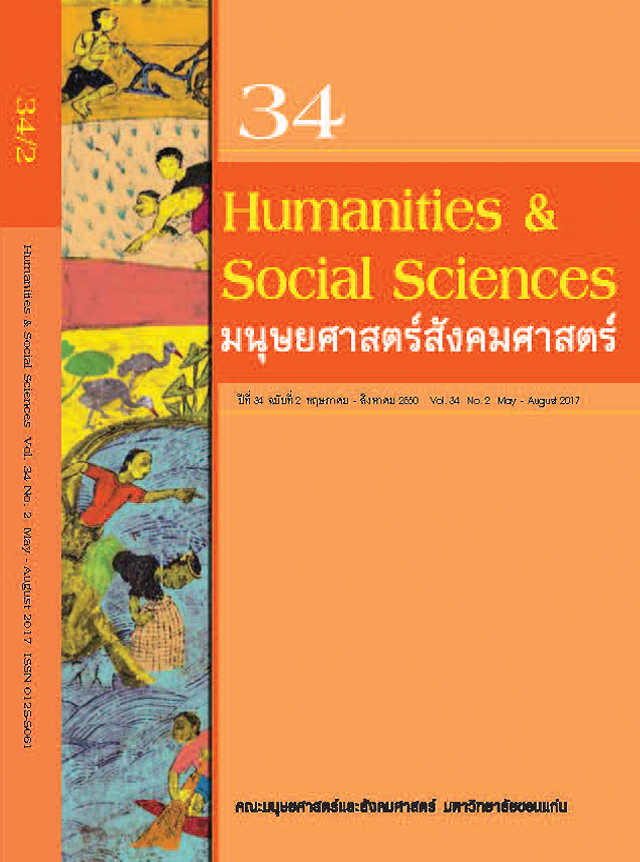การใช้ภาษาและพลังชีวิตของภาษาที่มีการพลัดถิ่นในประเทศไทย: กรณีศึกษาภาษาอีสานในจังหวัดพะเยา; Language Use and Language Vitality of a Displaced Language in Thailand: A Case Study of Isan language in Phayao Province
Keywords:
ภาษาพลัดถิ่น, การใช้ภาษา, พลังชีวิตของภาษา, ภาษาอีสาน, displaced languages, language use, language vitality, IsanAbstract
หมู่บ้านร่องส้าน ต.ร่มเย็น อ.เชียงคำ จ.พะเยา คือหนึ่งในชุมชนอีสานที่ตั้งรกรากอยู่ท่ามกลางหมู่บ้านของชาวเหนือในช่วงห้าทศวรรษที่ผ่านมา หมู่บ้านร่องส้านถือเป็นหมู่บ้านที่มีความหลากหลายทางภาษาอย่างแท้จริง เนื่องจากมีผู้คนจากหลายชนเผ่า อาทิเช่น คนอีสาน คนเหนือ คนม้ง และคนไทลื้อ กรณีศึกษานี้จึงมีวัตถุประสงค์เพื่อศึกษาการใช้ภาษา และพลังชีวิตของของภาษาอีสานซึ่งมีการพลัดถิ่นจากรกรากดั้งเดิม การศึกษาครั้งนี้เก็บข้อมูลจากผู้บอกภาษาจำนวน 18 คน แบ่งเป็นชาย 9 คน และหญิง 9 คน ในสามช่วงอายุ ได้แก่ วัยรุ่น (15-25 ปี) วัยกลางคน (35-50 ปี) และ วัยสูงอายุ (60 ปีขึ้นไป) ผลการวิจัยพบว่า ผู้บอกภาษาในทุกช่วงอายุยังคงใช้ภาษาอีสานในชีวิตประจำวันมากที่สุด มีการใช้ภาษาอีสานในการสนทนาภายในกลุ่ม และใช้ภาษาไทยถิ่นเหนือเพื่อวัตถุประสงค์ของงานชุมชน นอกจากนี้ยังพบอีกว่า การใช้ภาษาสัมพันธ์กับอายุของผู้บอกภาษา แต่ไม่พบความแตกต่างเรื่องเพศ จากการวิเคราะห์สถานการณ์ปัจจุบันของการใช้ภาษาภายในหมู่บ้าน พลังชีวิตของภาษาของภาษาอีสานในหมู่บ้านร่องส้านจึงถูกจัดไว้ในกลุ่ม 6b (ถูกคุกคาม) ในมาตร EGIDS โดยมีข้อเสนอแนะว่า ชาวบ้านควรจะรักษาภาษาพูดอีสานไว้เพื่อให้ภาษาอีสานเลื่อนขึ้นไปอยู่ในกลุ่ม 6a (มีพลัง) เพื่อให้มีการใช้ภาษาพูดอย่างยั่งยืน
Abstract
Rongsan village, Romyen Sub-district, Chiang Kham district, in Phayao province is one of the Isan communities, which is settled among Northern villages for over the past five decades. The village is a truly multilingual community which includes people from various ethinc groups, i.e. Isan, Northern Thai, Hmong, and Tai Lue people. This study aims to assess language use and language vitality of the Isan language which is displaced from its original location. The data was collected from 18 subjects; nine males and nine females from three different age groups: young (15-25 years old), middle-aged (35-50 years old), and elderly (over 60 years old). The findings indicated that the people of all age groups used Isan the most in their daily lives. Isan was used as an ‘in-group’ language, while Northern Thai was mostly used for community purposes. It was found that the use of Northern Thai correlated with the age of speakers, whereas there was not much distinction regarding genders. Having analyzed the current situation of language use within the village, language vitality of the Isan language in Rongsan village is in level 6b (threatened) in the EGIDS scale. It is recommended that the villagers keep maintaining Isan orally to move the language up to level 6a (Vigorous) to reach a sustainable level of language use.



